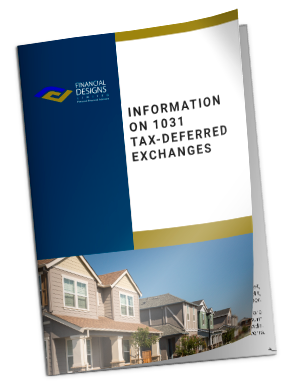1031 Exchanges

An Overview Of A 1031 Exchange
Why Exchange?
The 1031 Exchange can be a great way for investors to potentially build wealth by deferring taxes that would otherwise be due on the sale of an investment property. We encourage all investors to understand their specific potential tax liability as they decide if an exchange could benefit them or fits with their long-term financial objectives.
While each investor’s situation and conditions are different, we find that many investors estimate their total tax liability associated with a sale in the range of 25% – 40%. The exchange allows for deferral of these liabilities. Many strategies are available to meet specific long-term objectives.
Section 1031 Requirements
It is absolutely critical to follow the requirements for 1031 exchanges to the letter in order to realize the investment benefits and avoid costly penalties.
The exchange process must be facilitated by a Qualified Intermediary (QI), the professional who actually executes the exchange. QIs hold the proceeds from the property you sell until they are reinvested in the replacement property. There must be a written “exchange agreement” between you and the QI to prevent you from having “constructive receipt” of the funds during the exchange period. The QI is required to complete a valid 1031 exchange that ensures all rules are followed and equity is preserved during the process. Using a QI as an independent third-party to facilitate a tax-deferred exchange is a safe harbor established by Treasury Regulations, and it is very important for you to select a QI before closing on the sale of your property. We can work with any authorized QI of your choice, or we can suggest one who is fully bonded and has a national reputation.
The properties involved must be “like-kind”. This requirement is liberally interpreted, and virtually all real estate properties, whether raw land or those with substantial improvements, qualify as like-kind. However, REITs, real estate funds or other securities do not qualify for 1031 exchange.

1031 Exchange Options
As investors look for “like -kind” replacement properties for their exchange, many options exist. Investors are only constrained by market conditions, their buying power and availability. They have opportunities for both actively managed and passively managed investments. They have opportunities of separate full ownership or fractional ownership positions. Our firm is experienced in all property types and is primarily focused on passive replacement property options for our clients.1031 Replacement Property Investment Types or Structures
Active Management
Direct Ownership (fee simple)
What most investors think of when contemplating a replacement property purchase. One investor buys one property. The investor enjoys total control of the management and operation and financial performance. The investor makes decisions on purchase conditions, financing structure, due diligence requirements, ongoing management and timing of future sale (exit). For the investor interested in this level of active management and control, direct ownership is the ideal situation.
Net Leased Property
Net Lease Property is another direct ownership and active management option for investors interested in control and decision making. Generally net leased properties are single tenant properties where the tenant’s lease dictates the tenant’s responsibilities for the property. In most cases, the tenant takes on the management and maintenance responsibilities for the property. Some are advertised as “no landlord responsibility”. These properties come with their own risk profile including the tenants long term viability.Delaware Statutory Trusts (DSTs)
A Delaware Statutory Trust permits fractional ownership in a single property or multiple properties and qualifies as replacement property as part of an investor’s 1031 exchange. This is a passive option where the investor relies on an experienced professional real estate investment management firm (the Sponsor) to acquire, operate, manage, exit and make all decisions for the investment on behalf of all beneficial interest owners. DST properties are typically institutional quality properties like what an insurance company, pension fund or REIT might acquire. Approved accredited investors can use the exchange process and the DST to reposition and diversify their real estate holdings across various geographies and property types to change the overall risk profile of their holdings.Tenants in-Common (TIC) Property
Similar to the DST, the TIC structure allows for fractional ownership positions in larger institutional type real estate. This structure is also considered to be a passive investment. TIC properties generally have a limited number of investors per program, by requirement, lending qualifications or law. TIC owners have some voting rights, and complexities can arise if all investors don’t agree on a decision. Minimum investment requirements are generally higher in a TIC investment vs. a DST.
Free Guide to 1031 Exchanges & DSTs
Download a Free Guide to Learning About 1031 Exchanges & DSTs
It is important to note that DST investing is subject to specific eligibility criteria, and only individuals who meet the definition of an accredited investor are permitted to participate.
DST 1031 properties are only available to accredited investors (typically defined as having a $1 million net worth excluding primary residence or $200,000 income individually/$300,000 jointly of the last two years; or have an active Series 7, Series 82, or Series 65). Individuals holding a Series 66 do not fall under this definition) and accredited entities only. If you are unsure if you are an accredited investor and/or an accredited entity, please verify with your CPA and Attorney. Before considering a DST investment, it is crucial to evaluate your eligibility as a qualified investor. Our team is committed to assisting you in this process, ensuring that you meet the necessary requirements to participate in DST opportunities. Additionally, we are here to address any questions you may have and provide detailed information to guide your investment decisions.
Please be aware that DST investments involve risks and considerations which include but are not limited to substantial fees and expenses, inability of the DST to actively manage the property, strict timing limitations and risk of not meeting requirements for 1031 exchange tax treatment, and other negative tax consequences. There are risks associated with investing in real estate and Delaware Statutory Trust (DST) properties including, but not limited to, loss of entire investment principal, declining market values, tenant vacancies, lack of liquidity with restrictions on ownership and transfer. Potential cash flow, returns and appreciation are not guaranteed and could be substantially lower than anticipated. Diversification does not guarantee profits or protection against losses.
Additional risks and considerations related to investing in 1031 DST commercial real estate include, but are not limited to, general real estate risks, financing risks, tax risks, interest rate risk, management risks, operating risk, market risks such as supply and demand, changing market demographics, tenant turnover, tenants inability to pay rent, acts of God such as earthquakes, floods or other uninsured losses. There are also potential risks relating to the trust structure and the potential for adverse changes in laws and regulations. This material is not to be interpreted as tax or legal advice.

